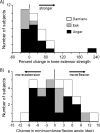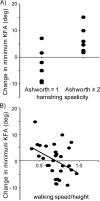Characteristics associated with improved knee extension after strength training for individuals with cerebral palsy and crouch gait
- PMID: 22699100
- PMCID: PMC3579590
- DOI: 10.3233/PRM-2012-0201
Characteristics associated with improved knee extension after strength training for individuals with cerebral palsy and crouch gait
Abstract
Muscle weakness may contribute to crouch gait in individuals with cerebral palsy, and some individuals participate in strength training programs to improve crouch gait. Unfortunately, improvements in muscle strength and gait are inconsistent after completing strength training programs. The purpose of this study was to examine changes in knee extensor strength and knee extension angle during walking after strength training in individuals with cerebral palsy who walk in crouch gait and to determine subject characteristics associated with these changes. A literature review was performed of studies published since January 2000 that included strength training, three-dimensional motion analysis, and knee extensor strength measurements for individuals with cerebral palsy. Three studies met these criteria and individual subject data was obtained from the authors for thirty crouch gait subjects. Univariate regression analyses were performed to determine which of ten physical examination and motor performance variables were associated with changes in strength and knee extension during gait. Change in knee extensor strength ranged from a 25% decrease to a 215% increase, and change in minimum knee flexion angle during gait ranged from an improvement of 9° more knee extension to 15° more knee flexion. Individuals without hamstring spasticity had greater improvement in knee extension after strength training. Hamstring spasticity was associated with an undesired increase in knee flexion during walking. Subject-specific factors such as hamstring spasticity may be useful for predicting which subjects will benefit from strength training to improve crouch gait.
Figures



Similar articles
-
Distal femoral extension osteotomy and patellar tendon advancement to treat persistent crouch gait in cerebral palsy. Surgical technique.J Bone Joint Surg Am. 2009 Oct 1;91 Suppl 2:271-86. doi: 10.2106/JBJS.I.00316. J Bone Joint Surg Am. 2009. PMID: 19805590
-
Effect of floor reaction ankle-foot orthosis on crouch gait in patients with cerebral palsy: What can be expected?Prosthet Orthot Int. 2018 Jun;42(3):245-253. doi: 10.1177/0309364617716240. Epub 2017 Jul 11. Prosthet Orthot Int. 2018. PMID: 28693377
-
Can strength training predictably improve gait kinematics? A pilot study on the effects of hip and knee extensor strengthening on lower-extremity alignment in cerebral palsy.Phys Ther. 2010 Feb;90(2):269-79. doi: 10.2522/ptj.20090062. Epub 2009 Dec 18. Phys Ther. 2010. PMID: 20022999 Free PMC article. Clinical Trial.
-
Effectiveness of surgical and non-surgical management of crouch gait in cerebral palsy: A systematic review.Gait Posture. 2017 May;54:93-105. doi: 10.1016/j.gaitpost.2017.02.024. Epub 2017 Feb 24. Gait Posture. 2017. PMID: 28279852 Free PMC article.
-
The natural history of crouch gait in bilateral cerebral palsy: A systematic review.Res Dev Disabil. 2018 Sep;80:84-92. doi: 10.1016/j.ridd.2018.06.013. Epub 2018 Jun 27. Res Dev Disabil. 2018. PMID: 29960128
Cited by
-
A marker registration method to improve joint angles computed by constrained inverse kinematics.PLoS One. 2021 May 28;16(5):e0252425. doi: 10.1371/journal.pone.0252425. eCollection 2021. PLoS One. 2021. PMID: 34048476 Free PMC article.
-
The Effect of Peripheral Magnetic Stimulation on Functional Mobility and Morphology in Cerebral Palsy with Spastic Diplegia: A Randomized Controlled Trial.Life (Basel). 2025 Mar 7;15(3):416. doi: 10.3390/life15030416. Life (Basel). 2025. PMID: 40141760 Free PMC article.
-
Progressive resistance exercise increases strength but does not improve objective measures of mobility in young people with cerebral palsy.J Physiother. 2014 Mar;60(1):58. doi: 10.1016/j.jphys.2013.12.010. Epub 2014 May 9. J Physiother. 2014. PMID: 24856945 Free PMC article.
-
A Robotic Exoskeleton for Treatment of Crouch Gait in Children With Cerebral Palsy: Design and Initial Application.IEEE Trans Neural Syst Rehabil Eng. 2017 Jun;25(6):650-659. doi: 10.1109/TNSRE.2016.2595501. Epub 2016 Jul 27. IEEE Trans Neural Syst Rehabil Eng. 2017. PMID: 27479974 Free PMC article.
-
Evaluation by Expert Dancers of a Robot That Performs Partnered Stepping via Haptic Interaction.PLoS One. 2015 May 20;10(5):e0125179. doi: 10.1371/journal.pone.0125179. eCollection 2015. PLoS One. 2015. PMID: 25993099 Free PMC article.
References
-
- Gage JR. Surgical treatment of knee dysfunction in cerebral palsy. Clin Orthop Relat Res. 1990;253:45–54. - PubMed
-
- Jahnsen R, Villien L, Aamodt G, Stanghelle JK, Holm I. Musculoskeletal pain in adults with cerebral palsy compared with the general population. J Rehabil Med. 2004;36(2):78–84. - PubMed
-
- Graham H, Selber P. Musculoskeletal aspects of cerebral palsy. Journal of Bone & Joint Surgery, British Volume. 2003;85(2):157–166. - PubMed
-
- Johnson DC, Damiano DL, Abel MF. The evolution of gait in childhood and adolescent cerebral palsy. J Pediatr Orthop. 1997;17(3):392–396. - PubMed
-
- Opheim A, Jahnsen R, Olsson E, Stanghelle JK. Walking function, pain, and fatigue in adults with cerebral palsy: a 7-year follow-up study. Dev Med Child Neurol. 2009;51(5):381–388. - PubMed
Publication types
MeSH terms
Grants and funding
LinkOut - more resources
Full Text Sources
Medical
Molecular Biology Databases
Miscellaneous

